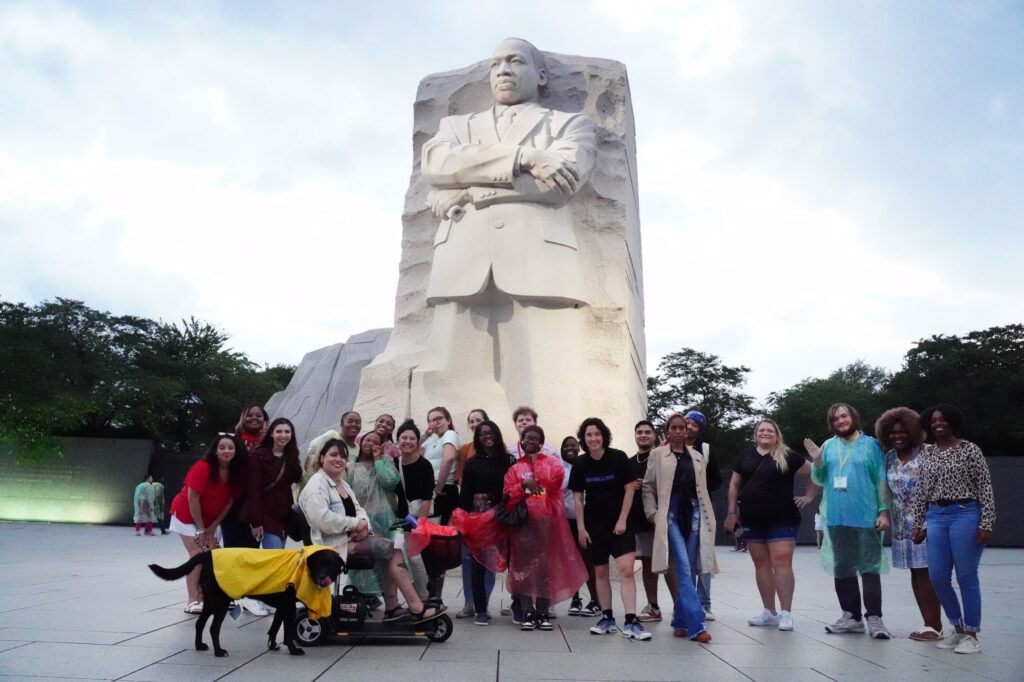Pictured above: Youth and adults from IEL’s Ready to Achieve Mentoring Program (RAMP) pose in front of the Martin Luther King, Jr. Memorial during the 2023 RAMP Annual Meeting.
33 years ago today, the Americans with Disabilities Act (ADA) was signed into law. This legislation enabled people that were, and still are, categorically discriminated against, to have full access to employment and educational opportunities.
IEL builds on the legacy of the ADA to ensure that people with disabilities can fully participate in all areas of life, including jobs, schools, transportation and beyond.
In 1991, one year after the signing of the ADA, IEL established the Center for Workforce Development (CWD). CWD aims to increase access and opportunities for youth with disabilities as they transition to adulthood by building the knowledge, skills and abilities of youth service professionals.
CWD’s Ready to Achieve Mentoring Program (RAMP)TM has supported thousands of young people over the last fourteen years, many of whom have a disability, to stay in school, improve their social support, and successfully transition into the workforce and postsecondary futures.
Since its inception, RAMPTM has been implemented in 32 communities across the nation and has developed over 1,400 partnerships with schools, employers, justice agencies and community groups. Participant data from the most recent cohorts show that 90% of youth stayed in school, 70% improved their school attendance and 70% saw an increase in their sense of social support.
Both ADA and the Individuals with Disabilities Education Act (IDEA) have made a significant impact on the lives of millions of people. However, the work toward equity and inclusion is far from over.
Students with disabilities continue to face barriers in access to quality education while workers with disabilities are continuously discriminated against, either directly on their jobs or indirectly through ableist job postings that describe tasks requiring physical labor that are not necessary for the job. Under IDEA, the federal government committed to paying 40 percent of the average per-pupil expenditure for special education, but this goal has never been achieved.
IEL’s annual Youth Transition Report underscores the persistent and pernicious gap between youth and young adults with disabilities and those without disabilities on measures of success in education, employment, opportunity and poverty.
The 2022 report shows that there remains “a significant gap in high school attainment when comparing students with and without disabilities, with the widest gap at more than 18.6 percent.” It also found that “college enrollment rates for young adults aged 18-24 with disabilities in the U.S. were 27.5 percent compared to the national average of 43.3 percent for young adults without disabilities.”
These statistics also correlate to trends for post-education life, with youth and young adults with disabilities (ages 14–24) about 15 percent less likely to be employed than their peers without disabilities across the nation. This contributes to the fact that youth and young adults with disabilities are also more likely to live in poverty than their peers without disabilities.
To continue our efforts to ensure all children and youth have what they need to learn, develop and become thriving members of their communities, IEL is committed to supporting efforts to increase funding to IDEA Part B and C and full funding for IDEA to fulfill the federal promise to provide 40 percent of the extra cost of special education. You can learn more about these goals and our other policy efforts here.
As we close out Disability Pride Month and reflect on 33 years of the ADA, we renew our dedication to supporting leaders overcoming barriers to building effective systems for all children and youth.
Explore more IEL resources for supporting youth and young adults with disabilities:
